Shooting thaler
A shooting thaler (/ˈtɑːlər/ TAH-lər; German: Schützentaler; French: Écu de tir) is a silver coin in thaler size minted to commemorate a Schützenfest (French: Fête de tir) or free shooting (German: Freischiessen, French: Tir libre) in Switzerland.
In a narrow sense, Swiss Schützentaler are the silver coins equal in size and weight to the Swiss 5 francs coin minted on the occasion of one of the Eidgenössische Schützenfeste, or federal shooting festivals. Three such coins were issued by the cantonal mints of Graubünden (1842, denominated at 4 Swiss francs[2]), Glarus (1847, denominated at 40 Batzen) and Geneva (1851, denominated at 10 francs) prior to the establishment of the Federal Mint. The Federal Mint has issued fifteen such coins with the nominal value of five francs, between 1855 and 1885.
These coins were not intended as legal tender, even though they were issued by the federal mint with a nominal face value. Because they were minted to the official specifications of the 5 francs coin, they were nevertheless circulated de facto.[3] After 1885, the federal mint was dissuaded from minting these semi-official coins on the part of the Latin Monetary Union. After the demise of the Monetary Union, the Swiss federal mint issued two further Schützentaler, in 1934 and 1939, for a total of twenty distinct Schützentaler (3 cantonal, 17 federal). Of the 22 cantons of the Swiss Confederation, 18 are represented in these coins, the exceptions being Uri, Appenzell, Aargau and Valais.[4]
Most of the designs in the series depict strongly patriotic themes, frequently depicting the federal personification Helvetia alongside a cantonal or city personification, in some cases alluding to specific historical events. The 1851 (Geneva) and 1855 (Solothurn) thalers are an exception to this as they are identical in design to their circulating counterparts.
The entire series can be distinguished from the much more varied genre of shooting medals (Schützenmedaillen) by their adherence to the specifications of circulating coinage (with the exception of the three cantonal speciments, the Swiss 5 francs coin). All but the Stans (1861) and St. Gallen (1874) issues are denominated.
In a somewhat wider sense, the term Schützentaler is extended to non-official silver commemorative coins of thaler size, minted privately for the federal festivals between 1890 and 1929 and from 1949 to present, as well as for numerous cantonal festivals.
History
The first shooting medals were struck in honor of the Officers' Shoot held in Langenthal, Bern, in 1822.[5][6] Shooting medals continued to be made in great numbers, minted in a variety of metals, including silver, bronze, gold and white metal.[5]
The first shooting thalers were cantonal pieces, minted in the 1840s by Grisons and Glarus as sovereign cantons of the Restored Confederacy. The third was minted by Geneva in 1851, already as a canton of the Swiss Confederation but before the federal mint had become fully operational. These four thalers, as well as the 1855 Solothurn federal issue, were strictly legal tender.[7] The Geneva issue of 1851, with a mintage of only 1,000 pieces, is the rarest of the shooting thalers, and has consequently attained the highest collector's value, selling for upward of CHF 1,500.[8]
All nineteenth-century federal shooting thaler issues were minted to legal fineness, and were given the denomination of five francs.[7] But from 1865, Switzerland was a member of the Latin Monetary Union,[9] and since the shooting thalers were not included in the mintages authorized by the Union, they are considered semi-medallic, and not technically legal tender even though they did circulate de facto, and their circulation was tolerated by the federal authorities.[7] The last thaler of this series is the 1885 Bern issue. After this time, Switzerland was dissuaded from further issuing these semi-official coins by the Latin Monetary Union.[3]
Although the term Schützentaler is mostly reserved for the Swiss tradition, some German mints in the 19th century have also issued commemorative coins for Schützenfeste. Examples include the German States of Baden,[10] Bremen,[11] Frankfurt am Main[12] and Hanover,[13]
In 1927, the Monetary Union ceased to exist.[9] Mintage began on a new series of shooting thalers in 1934 in honor of the shooting festival in Fribourg, and another design was issued in 1939 for the Lucerne festival. The 1934 issue was the last official shooting thaler that matched the circulating counterpart in both diameter and weight. The 1939 issues were not the same size and weight as their circulating counterparts, but both issues were redeemable only at the shooting festival or participating businesses.[7] The federal festival, and with it the production of shooting thalers, was interrupted by the outbreak of World War II.[14]
For the federal festivals of 1949 to 1977, commemorative coins were made but not to official specifications. With the rising popularity of collecting commemorative coins in the 1980s, fine silver coins dubbed Schützentaler have been privately issued for cantonal and federal festivals.
Cantonal issues
Chur (1842)
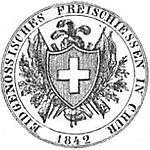
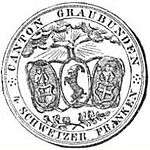
- Year: 1842
- Location: Chur
- Denomination: 4 francs
- Designer(s): Karl Friedrich Voigt
- Diameter: 40 mm (1.57 in)
- Coinage metal: Silver
- Mintage: 4,256[15]
- Notes: White metal and zinc pieces are known to have been struck. The zinc pieces were allegedly fixed in the center of a target during the shooting festival. If hit, the shooter would be given a larger award.[15]
| Details | Translation | |
|---|---|---|
| Obverse | EIDGENÖSSISCHES FREISCHIESSEN IN CHUR – 1842 | Federal Free Shoot in Chur – 1842 |
| Reverse | CANTON GRAUBÜNDEN – 4 SCHWEIZER FRANKEN | Canton of Graubünden – 4 Swiss francs |
| Edge | EINTRACHT MACHT STARK | Harmony is strength |
Glarus (1847)
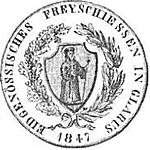
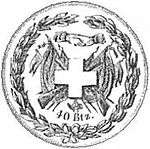
- Year: 1847
- Location: Glarus
- Denomination: 40 batzen
- Designer(s): S. Burger, Karl Friedrich Voigt
- Diameter: 40 mm (1.57 in)
- Coinage metal: Silver
- Mintage: 3,200[16]
- Notes: 1,023 pieces melted. White metal and zinc pieces are known to have been struck. The zinc pieces were allegedly fixed in the center of a target during the shooting festival. If hit, the shooter would be given a larger award.[16]
| Details | Translation | |
|---|---|---|
| Obverse | EIDGENÖSSISCHES FREYSCHIESSEN IN GLARUS – 1847 | Federal Free Shoot in Glarus – 1847 |
| Reverse | 40 Btz. | 40 batzen |
| Edge | EINTRACHT MACHT STARK | Harmony is strength |
Geneva (1851)
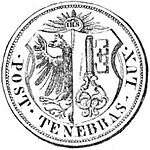
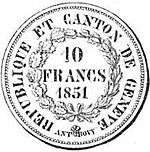
- Year: 1851
- Location: Geneva
- Denomination: 10 francs
- Designer(s): Antoine Bovy[17]
- Diameter: 48 mm (1.89 in)
- Coinage metal: Silver
- Mintage: 1,000[18]
- Notes: The design is identical to the regular 10 franc issues minted by Geneva at the time.[18] With a weight of 52 grams and the denomination of 10 rather than 5 francs, it is technically a double-thaler. At a mintage of 1,000 pieces, this is the rarest of the Swiss shooting thalers and is traded for upward of CHF 1,500.[8]
| Details | Translation | |
|---|---|---|
| Obverse | POST – TENEBRAS – LUX | Light after darkness |
| Reverse | REPUBLIC ET CANTON DE GENEVE – 10 FRANCS 1851 | Republic and Canton of Geneva – 10 francs 1851 |
| Edge | None | None |
Federal issues
1855–1885
Solothurn (1855)

- Year: 1855
- Location: Solothurn
- Denomination: 5 francs
- Designers: Friedrich Fisch, S. Burger, Karl Friedrich Voigt
- Diameter: 37 mm (1.46 in)
- Coinage metal: Silver
- Mintage: 3,000[19]
- Design:
- Obv.: Seated figure of Helvetia, holding shield with the federal coat of arms, pointing left, with mountains and ears of corn, HELVETIA
- 5 Fr. 1855, wreath of oak leaves and gentian
- Edge: EIDGEN. FREISCHIESEN SOLOTHURN 1855
- Notes: The design is identical to the regular federal 5 franc issues in use at the time, except for the inscription on the edge.[19] Imitations (made from genuine 5 francs coins of 1850) were reported as early as 1890.[20]
Bern (1857)
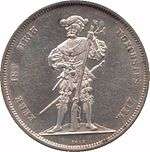

- Year: 1857
- Location: Bern
- Denomination: 5 francs
- Designer(s): Ferdinand Korn
- Diameter: 37 mm (1.46 in)
- Coinage metal: Silver
- Mintage: 5,191[21]
- Design:
- Obv.: Standing figure of a soldier with musket, EHRE IST MEIN HOECHSTES ZIEL. ("Honour is my highest aim"), signature KORN.
- Rev.: Two crossing rifles, Swiss cross in splendour in a wreath, 5 FRANKEN, EIDGENÖSSISCHES FREISCHIESSEN IN BERN 1857.
- Notes: Examples are known to have been struck in white metal.[21] The only known "Class II" specimen of the 1804 dollar, now in the National Numismatic Collection, was struck over a 1857 shooting thaler.
Zürich (1859)
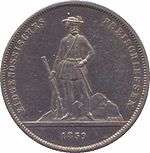
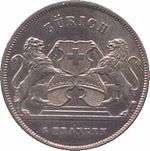
- Year: 1859
- Location: Zürich
- Denomination: 5 francs
- Designer(s): Ferdinand Korn
- Diameter: 37 mm (1.46 in)
- Coinage metal: Silver
- Mintage: 6,000[22]
- Design:
- Obv.: Standing figure of a soldier with rifle, EIDGENÖSSISCHES FREISCHIESSEN, 1859, signature KORN
- Rev.: Two cantonal coats of arms under a federal coat of arms, supported by two lions. ZÜRICH, 5 FRANKEN.
Nidwalden (1861)
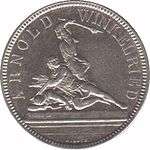
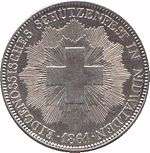
- Year: 1861
- Location: Stans, Nidwalden
- Denomination: 5 francs
- Designer(s): Antoine Bovy, Ferdinand Schlöth
- Diameter: 37 mm (1.46 in)
- Coinage metal: Silver
- Mintage: 6,000[23]
- Design:
- Obv.: The planned Winkelried monument in Stans,[24] ARNOLD WINKELRIED, signature A. BOVY
- Rev.: Swiss cross in splendour, EIDGENÖSSISCHES SCHÜTZENFEST IN NIDWALDEN – 1861
- Notes: Essai pieces are known to have been struck in white metal.[23]
La Chaux-de-Fonds (1863)
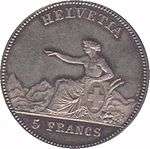

- Year: 1863
- Location: La Chaux-de-Fonds, Neuchâtel
- Denomination: 5 francs
- Designer(s): Antoine Bovy, Jacob Siber
- Diameter: 37 mm (1.46 in)
- Coinage metal: Silver
- Mintage: 6,000[25]
- Design:
- Obv.: Seated Helvetia figure, HELVETIA – 5 FRANCS
- Rev.: Neuchâtel cantonal coat of arms (the new coat of arms introduced after the 1857 Neuchâtel Crisis) with two rifles and two flags in saltire and a wreath, under a Swiss cross in splendour, TIR FEDERAL A LA CHAUX-DE-FONDS – JUILLET 1863, signature SIBER
- Notes: Examples are known to have been struck in white metal.[25]
Schaffhausen (1865)

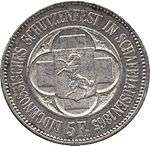
- Year: 1865
- Location: Schaffhausen
- Denomination: 5 francs
- Designer: Antoine Bovy
- Diameter: 37 mm (1.46 in)
- Coinage metal: Silver
- Mintage: 10,000[26]
- Design:
- Obv.: The city personification seated, holding a wreath, with the federal coat of arms on the seat, the Munot tower in the background, her left hand resting on the shoulder of Tell's son holding the pierced apple.
- Rev.: The Schaffhausen coat of arms in front of a Swiss cross in a Gothic ornament, EIDGENÖSSISCHES SCHÜTZENFEST IN SCHAFFHAUSEN 1865 – 5 Fr., signature A. BOVY
- Notes: Two examples are known to have been struck in gold.[26] There are forgeries in magnetic alloy.[27]
Schwyz (1867)


- Year: 1867
- Location: Schwyz
- Denomination: 5 francs
- Designer: Antoine Bovy
- Diameter: 37 mm (1.46 in)
- Coinage metal: Silver
- Mintage: 8,000[28]
- Design:
- Obv.: A lion rampant, holding a sword, supporting the cantonal shield. The lion's right back paw standing on a bow andquiver of arrows, the two Mythen peaks in the background, KANTON SCHWYZ, signature A. BOVY
- Rev.: A variety of weapons and four banners crossed behind the federal shield, wreath below, EIDGENÖSSISCHES SCHÜTZENFEST IN SCHWYZ 1867 – 5 Fr.
Zug (1869)

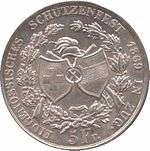
- Year: 1869
- Location: Zug
- Denomination: 5 francs
- Designer: Antoine Bovy
- Diameter: 37 mm (1.46 in)
- Coinage metal: Silver
- Mintage: 6,000[29]
- Design:
- Obv.: A medieval soldier with sword and half-armour, holding a halberd in his right hand, holding the cantonal banner in his left, HANS LANDWING RETTET DAS PANNER BEI ARBEDO ("Hans Landwing saves the banner at Arbedo"), 1422, signature A. BOVY SC.T
- Rev.:Feathered cap over the federal and cantonal shields, superimposed over crossed rifles and a wreath of oak and laurel, EIDGENÖSSISCHES SCHÜTZENFEST 1869 IN ZUG. 5 Fr.
- Notes: Four examples are known to have been struck in gold.[29]
Zürich (1872)

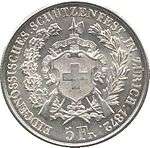
- Year: 1872
- Location: Zürich
- Denomination: 5 francs
- Designer: Fritz Landry
- Diameter: 37 mm (1.46 in)
- Coinage metal: Silver
- Mintage: 10,000[30]
- Design:
- Obv.: The city personification standing, resting her right arm on the Zürich shield, her left holding aloft a wreath, at her feet gears and crops and a view of the lake, FÜR FREIHEIT UND VATERLAND ("for liberty and fatherland"), signature F. LANDRY
- Rev.: The federal shield superimposed over a fasces and two crossed rifles, with the motto ALLE FÜR EINEN – EINER FÜR ALLE ("all for one, one for all"), surrounded by a wreath of oak and laurel, EIDGENÖSSISCHES. SCHÜTZENFEST. IN. ZÜRICH. 1872. 5 Fr.
- Notes: The obverse design was also used for shooting medals issued for the same festival.[30]
St. Gallen (1874)

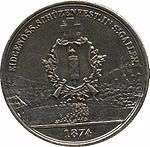
- Year: 1874
- Location: St. Gallen
- Denomination: 5 francs
- Designers: Fritz Landry, Antoine Bovy
- Diameter: 37 mm (1.46 in)
- Coinage metal: Silver
- Mintage: 15,000[31]
- Design:
- Obv.: Adrian von Bubenberg before the Battle of Murten: A kneeling knight, helmet deposited on the ground, holding the federal standard in his left, pointing with his sword to the left, in the background the rising Sun and the town of Murten, the Bernese troops shown on the right margin, 1474 A 1476, legend A. BOVY F.T
- Rev.: Coat of arms of St. Gallen superimposed over crossed rifles and wreath of oak and laurel. Swiss cross above, city view behind, EIDGENÖSS. SCHÜTZENFEST IN S.T GALLEN – 1874
- Notes: The scene references an episode before the battle: while the Bernese were in prayer, the sun burst from its cloud cover, and Bubenberg is said to have exclaimed "forth, brethren, God is illuminating our victory!".[32] The same composition was used by Durussel for a tin medal commemorating the battle in the same year.[33]
Lausanne (1876)
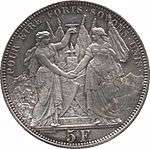
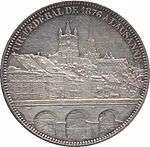
- Year: 1876
- Location: Lausanne
- Denomination: 5 francs
- Designer: Edouard Durussel
- Diameter: 37 mm (1.46 in)
- Coinage metal: Silver
- Mintage: 20,000[34]
- Design:
- Obv.: Helvetia and the personification of Vaud shaking hands, Vaud holding a wine goblet, cantonal and federal shields, flags and fasces in the background, flanked by grape vines and mountain scenery, 1836 · 1876 (1836 is the date of the first federal shooting festival in Lausanne), POUR · ETRE · FORTS SOYONS · UNIS · ("to be strong, let us be united"), 5 F, signature DURUSSEL
- Rev.: View of the city of Lausanne, TIR FÉDÉRAL DE 1876 LAUSANNE
- Notes: The reverse design was used on a shooting medal issued for the same festival.[34]
Basel (1879)


- Year: 1879
- Location: Basel
- Denomination: 5 francs
- Designer: Edouard Durussel
- Diameter: 37 mm (1.46 in)
- Coinage metal: Silver
- Mintage: 30,000[35]
- Design:
- Obv.: Standing Swiss soldier in Renaissance garb with Bidenhänder and Katzbalger, DAS SCHWERT ZUR HAND IM HERZEN GOTT SO WIRD D. SCHWEIZER NIE Z. SPOTT ("With sword in his hand and God in his heart, so will the Swiss never be disgraced"), signatures LANDERER, DURUSSEL.
- Rev.: Basel coat of arms supported by the basilisk in a circle of the 22 cantonal coats of arms , EIDG. SCHÜTZENFEST IN BASEL 1879, 5 Fr.
- Notes: Two varieties exist. One variety depicts rays between the sword and leg, while the other does not. Examples are known to have been struck in white metal.[35]
Fribourg (1881)


- Year: 1881
- Location: Fribourg
- Denomination: 5 francs
- Designer: Edouard Durussel
- Diameter: 37 mm (1.46 in)
- Coinage metal: Silver
- Mintage: 30,000[36]
- Design:
- Obv.: Two Swiss oldiers, one wielding a crossbow and the other a halberd, supporting Fribourg and Solothurn shields, respectively, seated at the feet of Helvetia holding the federal flag, ENTRÉE DE FRIBOURG & SOLEURE DANS LA CONFÉDÉRATION SUISSE 1481 ("Entry of Fribourg and Solothurn into the Swiss Confederation, 1481"), signature E. DURUSSEL.
- Rev.: Swiss cross in splendour above a city view of Fribourg, TIR FÉDÉRAL À FRIBOURG 1881, 5 Fr.
Lugano (1883)
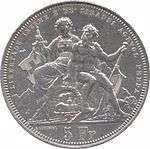
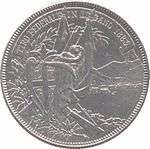
- Year: 1883
- Location: Lugano
- Denomination: 5 francs
- Designer(s): Edouard Durussel
- Diameter: 37 mm (1.46 in)
- Coinage metal: Silver
- Mintage: 30,000[37]
- Design:[38]
- Obv.: Seated Helvetia with Ticino as river god, Helvetia is holding a sword federal shield, Ticino an oar with cantonal colours, both are sitting on the Gotthard Tunnel (opened 1882), from which a locomotive is emerging, LIBERTADE INERME É DE' TIRANNI AGEVOL PREDA ("Defenseless liberty is easy prey for tyrants"), 5 Fr, signature E. DURUSSEL.
- Rev.: Shield of Lugano with Gothic ornaments, superimposed over two rifles, two banners and a laurel branch, a feathered cap and cloak resting on the shield, view of the lake and city on the right, TIRO FEDERALE IN LUGANO 1883.
Bern (1885)
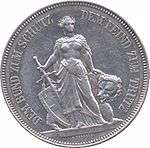

- Year: 1885
- Location: Bern
- Denomination: 5 francs
- Designers: Edouard Durussel, Christian Bühler
- Diameter: 37 mm (1.46 in)
- Coinage metal: Silver
- Mintage: 25,000[39]
- Design:
- Obv.: Standing Helvetia holding sword and federal shield, in front of the Bernese bear, her left hand resting on the bear's shoulder, DEM BUND ZUM SCHUTZ DEM FEIND ZUM TRUTZ ("To protect the federation, to defy the enemy"), signature E. DURUSSEL.
- Rev.: Bernese coat of arms superimposed over crossed rifles, wreath of oak leaves and gentian, Swiss cross in splendour above, EIDGENÖSSISCHES SCHÜTZENFEST IN BERN · 1885, 5 Fr., signature C. BÜHLER INV.
- Notes: Examples are known to have been struck in white metal.[39]
1934–1939
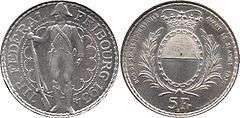
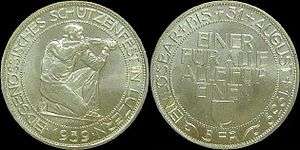
The shooting thalers of 1934 and 1939 were the final two specimens issued by the Swiss federal mint. They did have the traditional denomination of 5 francs, but with the added instruction that the coins were only redeemable for this amount at the festival itself. The 1934 coin had the legend Bon de 5 Fr. remboursable avant le 31 août 1934 ("voucher for 5 francs redeemable before 31 August 1934") and the 1939 one had Einlösbar bis 31. August 1939 ("redeemable until 31 August 1939).
They are minted to the new specification for 5 franc coins, reduced from 37 mm, 25 grams Ag 90% (22.5 g fine silver) to 31 mm, 15 grams Ag 83.5% (12.525 g fine silver), and thus no longer of "thaler" size.
| Location | Date | Denomination | Coinage metal | Mintage[40] | KM number | Haberling number |
|---|---|---|---|---|---|---|
| Fribourg | 1934 | 5 francs | Silver | 40,650 | S18 | H20a |
| Fribourg | 1934 | 100 francs | Gold | 2,000 | S19 | H21 |
| Lucerne | 1939 | 5 francs | Silver | 40,000 | S20 | H22 |
| Lucerne | 1939 | 100 francs | Gold | 6,000 | S21 | H23 |
Private issues
1890–1929
Silver medals for the federal festivals of 1890–1929 are sometimes referred to as Schützentaler. Most of these were also minted in bronze and in gold. The medals of 1890 to 1901 were minted in full thaler size (or somewhat larger), with a diameter of 45 mm and a silver weight above 38 grams. Beginning in 1904, the medals became smaller, in 1924 reduced to 10 grams of silver (reflecting the silver hausse in the wake of the First World War).
| Location | Date | Design | Size | Weight | Mintage | Richter nr. |
|---|---|---|---|---|---|---|
| Frauenfeld | 1890 | obv. allegory of Helvetia shielding Thurgau, Frauenfeld Castle, date 1803; rev. Frauenfeld arms (Hugues Bovy) | 45 mm | 38.8 g | 1250 | |
| Glarus | 1892 | obv.: soldier in Renaissance garb with halberd, his left resting on an oval shield with Glarus arms, oak leaves, panorama of Glarus in the background, FÜR EHR UND WEHR; rev.: rifle and laurel branch crossing behind cup trophy with Glarus arms, EIDGEN. SCHÜTZENFEST IN GLARUS 1892 (F. Homberg, Bern) | 45 mm | 43 g (Ag) | 50 (Ag) | 807 |
| Glarus | 1892 | obv. standing Helvetia with panoramic view of Glarus, GEDENKET DER THATEN EURER VAETER ("remember the deeds of your fathers"); rev. Glarus coat of arms (Huguenin frères) | 45 mm | 38.8 g (Ag), 67.8 g (Au) | 55 (Au) | 808 |
| Winterthur | 1895 | Georges Hantz, H. Wildermuth | 45 mm | 38.6 g (Ag) | 1756 | |
| Neuchâtel | 1898 | F. Landry | 45 mm | 38.3 g (Ag) | 970 | |
| Lucerne | 1901 | obv.: helmeted Helvetia head in profile with branch of gentian, Tell's chapel in background; rev.: Lucerne arms with laurel branch imposed over Swiss cross, EIDGENOESSISCHES SCHVETZENFEST 1901 (Hans Frei) | 45 mm | 36 g (Ag) | 879 | |
| St. Gallen | 1904 | Huguenin frères | 33 mm | 16 g | 4,759 (Ag) | 1175 |
| Zürich | 1907 | obv.: Helvetia with edelweiss wreath and city personification in profile; rev.: laurel branch, EIDGENOESSISCHES SCHUETZENFEST IN ZUERICH 1907 (Bosch, Huguenin) | 10.4 g (Ag), 15.2 g (Au) | 400 (Au) | 1793 | |
| Bern | 1910 | 13.3 g (Au) | 263 | |||
| Bern | 1910 | 28 mm | 14 g (Ag) | 264 | ||
| Aarau | 1924 | obv.: kneeling William Tell, „DU KENNST DEN SCHÜTZEN“ ("Thou know'st the marksman"[41]); rev.: heraldic eagle haloed with Swiss cross, EIDG·SCHÜTZENFEST·AARAU·1924. Variant (Richter 44) has the additional inscription DEN MITARBEITERN GEWIDMET on the reverse. | 10 g (Au), 12.6 g (Ag) | 223 (Au) | 43, 44 | |
| Aarau | 1924 | obv.: Two men standing, rifles in their left hands, shaking hands, Swiss cross in square field of rays, AARAU 1824 1924; rev.: JAHR=HVNDERTFEIER DES SCHWEIZ. SCHV̈TZENVEREINS (Hans Frei, J. Schwyzer) | 50 mm | 60 g (bronze) | 45 | |
| Bellinzona | 1929 | 50 mm | 65 g (bronze) | 1465 | ||
| Bellinzona | 1929 | obv. a girl sitting on a rock; rev. a triple fountain representing Rhone, Ticino and Rhine (RODANO, TICINO, RENO), TIRO FEDERALE - BELLINZONA 1924 (Huguenin / Ballestra) | 27 mm | 13 g | 2,500 | 1467 |
1949 to present
The federal festivals had commemorative medals minted in silver and gold. These do not have a face value in francs and are typically called Schützenmedaille rather than Schützentaler.
| Location | Date | Design | Mintage | Richter nr. |
|---|---|---|---|---|
| Chur | 1949 | 857 | ||
| Lausanne | 1954 | Henri Guisan, It recte nihil timet (Lasserre) | 1649 | |
| Biel | 1958 | Huguenin | ||
| Zürich | 1963 | F. Fischer | ||
| Thun | 1969 | K. Jacobsen | ||
| Zürich | 1977 | Lenz | ||
| Chur | 1985 | |||
Beginning in 1982, commemorative silver medals in gold and silver have been produced for various local shooting events by the private company CIT Coin Invest.[42] The same company has also offered "Schützentaler" for the federal shooting festival from 1990 onward.
These medals have more often been termed "Schützentaler" because a nominal face-value in Swiss Francs was re-introduced. These denominations are fictional and not related to any Swiss monetary authority, the medals are technically tokens or vouchers that could be redeemed for the stated amount at the respective festivals, but their selling price far exceeds their face value and they are sold as collector items.
| Location | Date | Denomination | Coinage metal | Mintage[43] | KM number | Haberling number |
|---|---|---|---|---|---|---|
| Winterthur | 1990 | 50 francs | Silver | 5,000 | H39a | |
| Thun | 1995 | 50 francs | Silver | 5,000 | S46 | H49a |
| Thun | 1995 | 500 francs | Gold | 500 | S47 | H50 |
| Bière | 2000 | 50 francs | Silver | 3,500 | S59 | H62 |
| Bière | 2000 | 500 francs | Gold | 300 | S60 | H63a |
| Aarau | 2010 | 50 francs | Silver | 2,000 | S79 | H83a |
| Aarau | 2010 | 500 francs | Gold | 200 | S80 | H84a |
| Valais[44] | 2015 | 50 francs | Silver | 1,200 | - | H93a |
| Valais[44] | 2015 | 500 francs | Gold | 200 | - | H94a |
| Lucerne[45] | 2020 | 50 francs | Silver | 1,000 | - | |
| Lucerne[45] | 2020 | 500 francs | Gold | 125 | ||
The following table shows other "Schützentaler" commemorative coins produced by CIT Coin Invest since 1982. Every year since has seen the mintage of two coins, each bearing the same design, one struck in silver, the other in gold. The only exceptions are the issues of Zürich and Sion in 1999, one of which was struck in copper–nickel, two in silver and two in gold. Until 1995, silver issues were denominated at fifty francs, while gold pieces were denominated at 1,000 francs. Later, gold issues were denominated at 500 francs, excepting only the Zürich issues of 1999.
| Event | Date | Denomination | Coinage metal | Mintage[46] | KM number | Haberling number |
|---|---|---|---|---|---|---|
| Eidg. Feldschiessen, Oberhasli | 1984 | 50 francs | Silver | 6,300 | S22 | H24a & H24b |
| Eidg. Feldschiessen, Oberhasli | 1984 | 1,000 francs | Gold | 300 | S23 | H25 |
| Schützenfest Altdorf | 1985 | 50 francs | Silver | 3,500 | S24 | H26a |
| Schützenfest Altdorf | 1985 | 1,000 francs | Gold | 300 | S25 | H27 |
| Eidg. Feldschiessen, Appenzell | 1986 | 50 francs | Silver | 3,700 | S26 | H28a |
| Eidg. Feldschiessen, Appenzell | 1986 | 1,000 francs | Gold | 300 | S27 | H29 |
| Glarus | 1987 | 50 francs | Silver | 3,200 | S28 | H1a |
| Eidg. Feldschiessen, Glarus | 1987 | 1,000 francs | Gold | 300 | S29 | H32 |
| Aargauisches Kantonalschützenfest, Brugg | 1988 | 50 francs | Silver | 3,000 | S30 | H33a & H33b |
| Aargauisches Kantonalschützenfest, Brugg | 1988 | 1,000 francs | Gold | 400 | S31 | H34 |
| Zuger Kantonalschützenfest, Menzingen | 1989 | 50 francs | Silver | 2,200 | S32 | H36a & H36b |
| Zuger Kantonalschützenfest, Menzingen | 1989 | 1,000 francs | Gold | 250 | S33 | H37 |
| Langenthal | 1991 | 50 francs | Silver | 4,000 | S38 | H41a |
| Langenthal | 1991 | 1,000 francs | Gold | 400 | S39 | H42a |
| Zürcher Kantonalschützenfest Dielsdorf | 1992 | 50 francs | Silver | 1,750 | S40 | H43a & H43b |
| Zürcher Kantonalschützenfest, Dielsdorf | 1992 | 1,000 francs | Gold | 175 | S41 | H44 |
| Thurgauer Kantonalschützenfest, Weinfelden | 1993 | 50 francs | Silver | 2,200 | S42 | H45a |
| Thurgauer Kantonalschützenfest, Weinfelden | 1993 | 1,000 francs | Gold | 200 | S43 | H46 |
| St. Galler Kantonalschützenfest, Rorschach | 1994 | 50 francs | Silver | 2,200 | S44 | H47a |
| St. Galler Kantonalschützenfest, Rorscach | 1994 | 1,000 francs | Gold | 200 | S45 | H48 |
| Sempach | 1996 | 50 francs | Silver | 1,500 | S48 | H51a |
| Luzerner Kantonalschützenfest, Sempach | 1996 | 500 francs | Gold | 96 | S49 | H52 |
| Schaffhauser Kantonalschützenfest, Neuhausen am Rheinfall | 1997 | 50 francs | Silver | 1,500 | S50 | H53a |
| Schaffhauser Kantonalschützenfest, Neuhausen am Rheinfall | 1997 | 500 francs | Gold | 97 | S51 | H54 |
| Schwyzer Kantonalschützenfest, Schwyz | 1998 | 50 francs | Silver | 1,500 | S52 | H55 |
| Schwyzer Kantonalschützenfest, Schwyz | 1998 | 500 francs | Gold | 98 | S53 | H56a |
| Zürich | 1999 | 5 francs | Copper–Nickel | 2,500 | S54 | H57 |
| Zürich | 1999 | 20 francs | Silver | 1,000 | S55 | H58 |
| Walliser Kantonalschützenfest, Sion | 1999 | 50 francs | Silver | 1,500 | S57 | H60 |
| Zürich | 1999 | 200 francs | Gold | 100 | S56 | H59 |
| Walliser Kantonalschützenfest, Sion | 1999 | 500 francs | Gold | 99 | S58 | H61a |
| Urner Kantonalschützenfest, Altdorf | 2001 | 50 francs | Silver | 1,500 | S61 | H64 |
| Urner Kantonalschützenfest, Altdorf | 2001 | 500 francs | Gold | 150 | S62 | H65a |
| Zürich | 2002 | 50 francs | Silver | 1,500 | S63 | H66 |
| Zürich | 2002 | 500 francs | Gold | 150 | S64 | H67a |
| Kantonalschützenfest beider Basel, Liestal | 2003 | 50 francs | Silver | 1,500 | S65 | H68 |
| Kantonalschützenfest beider Basel, Liestal | 2003 | 500 francs | Gold | 150 | S66 | H69a |
| Kantonalschützenfest Fribourg | 2004 | 50 francs | Silver | 1,500 | S67 | H70a & H70b |
| Kantonalschützenfest Fribourg | 2004 | 500 francs | Gold | 150 | S68 | H71a |
| Tiro Federale in Campagna, Brusio | 2005 | 50 francs | Silver | 1,500 | S69 | H72a & H72b |
| Tiro Federale in Campagna, Brusio | 2005 | 500 francs | Gold | 150 | S70 | H73 |
| Kantonalschützenfest Solothurn | 2006 | 50 francs | Silver | 2,000 | S71 | H74a |
| Kantonalschützenfest Solothurn | 2006 | 500 francs | Gold | 200 | S72 | H75a & H75b |
| Luzerner Kantonalschützenfest | 2007 | 50 francs | Silver | 2,000 | S73 | H77a |
| Luzerner Kantonalschützenfest | 2007 | 500 francs | Gold | 200 | S74 | H78 |
| Tir Cantonal Vaudois - La Côte & Maîtrise Genevoise | 2008 | 50 francs | Silver | 1,500 | S75 | H79a |
| Tir Cantonal Vaudois - La Côte & Maîtrise Genevoise | 2008 | 500 francs | Gold | 150 | S76 | H80a |
| Kantonalschützenfest Obwalden | 2009 | 50 francs | Silver | 1,500 | S77 | H81a |
| Kantonalschützenfest Obwalden | 2009 | 500 francs | Gold | 175 | S78 | H82a |
| Kantonalschützenfest Uri | 2011 | 50 francs | Silver | 1,500 | - | H85a |
| Kantonalschützenfest Uri | 2011 | 500 francs | Gold | 150 | - | H86a |
| Kantonalschützenfest Graubünden[47] | 2012 | 50 francs | Silver | 1,500 | - | H87a & H87b |
| Kantonalschützenfest Graubünden[47] | 2012 | 500 francs | Gold | 175 | - | H88a & H88b |
| Kantonalschützenfest Luzern[47] | 2013 | 50 francs | Silver | 1,000 | - | H89a |
| Kantonalschützenfest Luzern[47] | 2013 | 500 francs | Gold | 150 | - | H90a |
| Kantonalschützenfest Schaffhausen | 2014 | 50 francs | Silver | 1,200 | - | H91a |
| Kantonalschützenfest Schaffhausen | 2014 | 500 francs | Gold | 180 | - | H92a |
See also
| Wikimedia Commons has media related to Schützentaler. |
- Swiss franc
- Coins of the Swiss franc – Currently minted Swiss coins.
References
- Ferdinand Korn (1825 - ca. 1870), originally of Mainz, acted as chief engraver at the federal mint from 1855, as director in 1858/9. After a dispute with Bovy, he moved back to Germany, as master of the mint for the Duke of Nassau at Wiesbaden.
- prior to the introduction of the federal Swiss franc in 1850, "Swiss franc" was the name given to cantonal silver coins of one livre tournois.
- Swissmint FAQ, p. 9, citing Revue Suisse de Numismatique, 1894, p. 56.
- Zürich (1859, 1872) and Bern (1857, 1885) are represented twice; Unterwalden is represented with Stans (Nidwalden). Cantons represented by cities other than their capitals are Ticino (with Lugano) and Neuchâtel (with La Chaux-de-Fonds). The festival in Aarau (Aargau) of 1849 was held just before the federal mint became operative and again in 1924, when it had ceased to issue shooting thalers. Festivals in Lucerne were held in 1832 and 1901, with a federal issue Schützentaler minted only for the third event in 1939. The small cantons of Uri and Appenzell have never hosted a federal festival, the canton of Valais for the first time only in 2015.
- Krause, p. 11
- Krause, p. 10
- Bruce, p. 455
- Auctioned for CHF 1,600 in 2018 (Sincona Auction 47 - Part 2, Lot 3378); schweizer-geld.ch: CHF 1750 for "fine" condition, CHF 2500 for "very fine" condition (as of 2020).
- Kenen, Peter B. & Meade, Ellen E. (2008). Regional Monetary Integration Cambridge, United Kingdom: Cambridge University Press. ISBN 0-521-86250-7
- Krause & Mishler, p. 355
- Krause & Mishler, p. 373
- Krause & Mishler, p. 383
- Bruce, p. 155
- Searis, BJ. "Swiss Shooting Thalers". Professional Coin Grading Service. Retrieved 2015-02-27.
- Richter, p. 161
- Richter, p. 156
- Medalist Antoine Bovy (1795–1877) of Geneva, French citizenship 1835, employed by the federal mint for the Swiss franc coins in 1850/51 and 1873/4.
- Richter, p. 113
- Richter, p. 209
- Bulletin de la Societè Suisse de Numismatique 9 (1890), p. 29.
- Richter, p. 60
- Richter, p. 299
- Richter, p. 193
- The monument by Ferdinand Schlöth was at the time unfinished, commissioned in 1855 but inaugurated only in 1865.
- Richter, p. 180
- Richter, p. 199
- 1865 Schaffhausen Schützenfest FÄLSCHUNG
- Richter, p. 202
- Richter, p. 293
- Richter, p. 301
- Richter, p. 215
- Geßner, Geschichte der Schweizerischen Eidsgenossenschaft (1827), 521.
- iNumis, Mail Bid Sale 24, Lot 1754
- Richter, p. 274
- Richter, p. 45
- Richter, p. 93
- Richter, p. 245
- Victor Emmanuel III of Italy, Corpus Nummorum Italicorum vol. 4 (1913), p. 565; plate xlv (p. 634), no. 18. C.f. Richter 1372, Durussel's design for the 1882 Tiro cantonale liberta in Bellinzona (coinhirsch.com).
- Richter, p. 62
- Bruce, pp. 456–460
- Schiller (1804) act 4, sc. 3, trans. Martin (1900).
- 50 Jahre CIT Coin Invest, Münzenwoche 19 December 2019.
- Bruce, pp. 456–460
- "Swiss shooting talers for 2015 mark festival in Wallis (Valais)". Coin World. Archived from the original on 2015-02-27. Retrieved 2015-02-27.
- [https://deutschermuenzexpress.de/neuheiten/1633/50-chf-schuetzentaler-luzern-2020-silber-pp 50 CHF Schützentaler Luzern 2020 Silber PP ]
- Bruce, pp. 456–460
- "Swiss shooting taler available". Coin World. Archived from the original on 2015-04-02. Retrieved 2015-02-27.
Bibliography
- Bruce, Colin R. II Unusual World Coins Iola, Wisconsin: Krause Publications, 2007, ISBN 0-89689-576-9
- Krause, Chester L. & Mishler, Clifford Standard Catalog of World Coins 1801–1900, Krause Publications, 1996, ISBN 0-87341-427-6
- Krause, Delbert Ray Swiss Shooting Talers and Medals, Whitman Publishing Company, 1965
- Martin, Jean L. Les médailles de tir Suisse 1612–1939 Lausanne, 1972
- Richter, Jürg Die Schützentaler und Schützenmedaillen der Schweiz, 2005, ISBN 3-924861-95-1
- Haberling, Michael Swiss Shooting Festival Coins 1842 - 2015, 2015